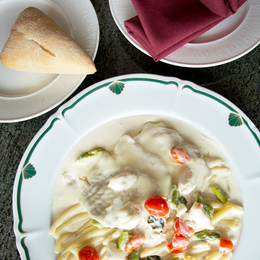
The Ultimate Foodie Guide
Recipes, how tos, and what to know.
Food has a way of bringing people together and we thought what better way to connect with our audience than by putting together our first-ever food lover’s guide. We covered all the bases, from learning how to properly make homemade pasta and the techniques you can practice to become a better wine expert to what you need to know when purchasing fresh seafood and why befriending your local butcher may be in your best interests. We also tapped a handful of South Jersey’s finest restaurants to provide us with a recipe for a standout dish pulled right from their menus so you can try to recreate the magic in your very own kitchen. We hope you brought an appetite.
The Basics on Bread
Whether it’s a dinner roll or a fine French baguette, not all bread is created equal. Here, Josue S. Negron of Dulce Artisanal Pastry in Collingswood gives us the goods on what to be on the lookout for when seeking out quality bread.
If you’re looking for a good crust, you want a golden color and crisp texture. “The caramelization of the sugars lends the bread that golden color and packs a lot of flavor as well,” Negron says. French-style artisanal breads will generally have such a crust, but possess a soft, airy crumb.
When you pair bread with a plate of food, you’re creating a new experience of that dish which can become complicated if prior thought isn’t factored in. “You may know the dense structure and adaptable flavor of the semolina works with your red sauce pasta dish, but what about French-style black olive and thyme batard? Or a beer bread boule?” says Negron.
Baking bread at home may be ambitious but Negron says the key is that the flavor you want to be at the fore-front should be incorporated in the final dough. “For example, the levain for a sour whole wheat or sour rye boule should use rye flour to provide structure for the bread, but only the sour rye has the rye flour in the final dough whereas the sour whole wheat has a comparable amount of whole wheat flour in its final dough,” he says.
How to Become a Better Wine Expert
Many people love nothing more than a glass of wine with dinner or perhaps as they decompress from a long day at the office, but not everyone enjoys wine in the same way. For every one of us who feel no shame drinking a glass of white poured from a box in the fridge, there is someone who would easily spend $1,000 on a coveted vintage. Indeed, to know wine is to love wine, but with so much ground to cover in between, trying to become well-versed in the culture isn’t that easy.
David Moore, co-founder of Moore Brothers Wine Company in Pennsauken, has been buying and selling wines for more than four decades along with his brother Greg and they have a saying they like to incorporate whenever someone asks them how they can become a more seasoned oenophile: “Wine’s a simple pleasure and a really complicated subject.”
So how can you become better educated without coming across as a total wine snob? We spoke with some local authorities in the matter to gain an increased understanding on some of the little things you can do to enhance your knowledge. Their advice may not make you an overnight sommelier, but following these tips can take you from novice to knowledgeable in no time.
For Starters
Before you can fully wrap your head around wine, you have to study the benchmarks that producers try to emulate. For example, no matter where in the world a bottle of Riesling is made, the benchmark is Germany. “It took me 20 years to realize this,” says Gary Pavlis, a Rutgers University professor and certified wine judge. “Everyone that wants to learn about wines should start with the benchmark.” This allows you to get a foundation of taste and flavor profile so that when you sample a variety that is different from the benchmark, you can identify the nuances more easily and help give yourself a better sense of wine from a worldwide perspective.
Read the Label
“Understanding a wine label is huge,” says George Katsikis, general manager of Caffe Aldo Lamberti in Cherry Hill. “California calls their wines by the grape, France by the region. … You have to understand what are you are drinking.” Also, knowing a thing or two about vintage can be huge. Little pocket guides can inform you about certain years and other notable factors such as how the weather may have affected the wine during that growing season.
Estate Wines
When looking for a truly great bottle of wine, it doesn’t necessarily need to cost an arm and a leg, but it should be produced in small batches. “If the wine is in every liquor store or if you see an ad for it in a magazine, you don’t buy it,” Moore says, citing the adjuncts placed by many large winemakers. “If a reasonably informed person had the choice of a jar of handmade marinara sauce from a woman in Abruzzi or a jar of Ragu, they’d choose the former because it would be a much better experience.” Katsikis calls these artisan bottles special because of the care and attention to detail put into their production. “The fruit is sourced from the estate, vinified on the estate and it is bottled on the estate; it’s a one-stop shop. They are not sourcing grapes from here and there and blending them,” he says. Because these wines are not overly produced, the consistent quality is overwhelmingly evident.
A Good Year
Whether you have a mini wine fridge or a full-blown cellar, storing and aging wine is
a must with certain bottles as they will only become more complex and enhanced.“The thing that people will start to realize when they get into wine is how wonderful it is when it ages,” Pavlis says. “There are wines that with time reach a whole other level of enjoyment. [For instance] I’ll never drink a Bourdeaux before it’s 10 years old.”
The Perfect Match
Fine food and fine wine are nearly synonymous, but not everyone grasps how to properly pair the two.
“The mistake people make is choosing the wine before they choose the food,” says Katsikis, who suggests thinking about what dish you are eating and what flavor profiles of wine will help elevate the experience, such as pairing a white wine with shellfish or a red with lamb. “People will say, I only drink white or I only drink red and that there are no rules, drink what you want, but I don’t get along with that,” Pavlis says. “If you have a cabernet with lobster it’s going to taste like cardboard.”
Raise a Glass
If you want to become a better wine expert you’ll have to drink more of it. “The only way to expand your knowledge is to drink as much variety as you can,” says Moore. “One of the things you’ll learn over time is how to identify good farming, just by tasting the wine and that can only happen when you drink [lots of it].” For Pavlis, experimenting is part of the fun. “You’ll never be a total wine expert, you’ll never know everything and that is the best part,” he says. Katsikis sums it up by saying no matter how well-versed he is in the subject, everyone’s palate is different and wine-making is a constant evolution.
“We learn every day.”
Why You Should Get to Know the Butcher
Walking into a butcher shop can be a bit overwhelming, if not a tad intimidating, with a case full of various cuts of meat, some foreign to the average person. But you see that guy behind the counter with the pencil behind his ear, wielding a cleaver and wearing the somewhat bloody apron? You should make friends with him immediately because the benefits are much greater than you can imagine.
Getting to Know Each Other
A trip to the butcher shop is not like walking the meat aisle at your supermarket where you simply peruse the selections and dump something in your cart. Rather, a butcher is all about the personal interaction with their customers, many of whom they’ll get to know by name quickly. “Most butchers love to share with customers and like to get to know them,” says Jeff Bringhurst, of Bringhurst Meats in Berlin. At Trim-Rite Meats in Washington Township, Steve Casalnova also cites the personalized service as being one of the biggest reasons to visit a butcher shop. “A customer walks through the door, they become our only focus. That never happens in a supermarket,” he says.
But Know the Difference
Any quality butcher knows more than just how to shoot the breeze with customers though, they also know how to handle whole animals. Whereas a meat cutter can open a vacuumed sealed bag of product and cut it into pieces, a true butcher can take an animal and make all the cuts, sausage, smoked meats, etc. “We can really serve our customers well from start to finish,” says Bringhurst.
Meat of the Matter
Having an event or hosting a large family gathering and need some help? That’s what butchers live for. Asking questions is not only OK, it’s encouraged so that they can best guide you in the right direction. That may include suggesting other cuts or helping you stay within budgetary constraints. “We can customize your purchase to fit your specific need, whether it’s one meal or for a party or special occasion,” says Casalnova.
A Fresh Approach
Butcher shops tend to carry a higher quality of product and “because [they] generally don’t have a ton of inventory, it assures a fresher product,” Casalnova says. “A butcher should also know what grades they carry and where they are sourced,” Bringhurst says. That means they can not only tell you where the animal came from, but how they were raised and how to best prepare them at home.
Forget the Cookbook
Bringhurst warns customers to not expect everything you prepare to look like a picture in a cookbook. In fact, he says “some cookbooks don’t use the actual cut in the photos.” That’s where a knowledgeable butcher can pay dividends. “Butchers know the best cuts of meat for your recipes, the quantity needed and the cooking instructions,” says Bringhurst.
Getting to Know Each Other
A trip to the butcher shop is not like walking the meat aisle at your supermarket where you simply peruse the selections and dump something in your cart. Rather, a butcher is all about the personal interaction with their customers, many of whom they’ll get to know by name quickly. “Most butchers love to share with customers and like to get to know them,” says Jeff Bringhurst, of Bringhurst Meats in Berlin. At Trim-Rite Meats in Washington Township, Steve Casalnova also cites the personalized service as being one of the biggest reasons to visit a butcher shop. “A customer walks through the door, they become our only focus. That never happens in a supermarket,” he says.
But Know the Difference
Any quality butcher knows more than just how to shoot the breeze with customers though, they also know how to handle whole animals. Whereas a meat cutter can open a vacuumed sealed bag of product and cut it into pieces, a true butcher can take an animal and make all the cuts, sausage, smoked meats, etc. “We can really serve our customers well from start to finish,” says Bringhurst.
Meat of the Matter
Having an event or hosting a large family gathering and need some help? That’s what butchers live for. Asking questions is not only OK, it’s encouraged so that they can best guide you in the right direction. That may include suggesting other cuts or helping you stay within budgetary constraints. “We can customize your purchase to fit your specific need, whether it’s one meal or for a party or special occasion,” says Casalnova.
A Fresh Approach
Butcher shops tend to carry a higher quality of product and “because [they] generally don’t have a ton of inventory, it assures a fresher product,” Casalnova says. “A butcher should also know what grades they carry and where they are sourced,” Bringhurst says. That means they can not only tell you where the animal came from, but how they were raised and how to best prepare them at home.
Forget the Cookbook
Bringhurst warns customers to not expect everything you prepare to look like a picture in a cookbook. In fact, he says “some cookbooks don’t use the actual cut in the photos.” That’s where a knowledgeable butcher can pay dividends. “Butchers know the best cuts of meat for your recipes, the quantity needed and the cooking instructions,” says Bringhurst.
How to Choose the Right Seafood
You don’t have to be a fishmonger to appreciate a beautifully seared tuna steak or a succulent lobster tail, but you should know a thing or two about the proteins you arepurchasing. With so many different species each with their own nuances in taste and flavor, seafood is vastly different from beef. So how can you tell what environment a fish was raised in? What should fresh seafood smell like? Is it true you can tell a lot about a fish by looking into its eyes? To find out the answers to these questions and more, we spoke with two seafood-centric chefs, Bill Fischer of Fischer’s Pelican in Washington Township and Mike Stollenwerk of Two Fish in Haddonfield, to gain some expertise.
The one thing to remember when buying fresh fish is that it should always be firm and have a nice color to it, according to Fischer. “The firmer the fresher and it should never have an odor of any kind,” Fischer says. Stollenwerk agrees. “Any fish that smells or tastes‘fishy’ are not fresh. It should smell clean and fresh like the ocean,” says Stollenwerk.
The Whole Picture
If buying a whole fish, there are several things that will gauge the freshness of the seafood. Stollenwerk says you’ll want to check the eyes to make sure they are bright and clear and not sunken and cloudy, which would signify the fish has been sitting around too long. He also recommends pressing the fish with your fingers. “It should spring back and not be soft andsquishy,” he says. The gills are another goodindicator, says Fischer. “The gills should be purple or red.” And don’t discard anything. “The head, bones and fins can be used to make fish stock which can be used for soups and sauces or frozen for later use,” offers Stollenwerk.
The Tail End of the Story
Both chefs prefer wild-caught fish to farm-raised, but in some instances, such as with salmon, there are exceptions, especially in the offseason. But you still have to pay attention and you’ll want to determine what type of environment the fish was raised in. “Check the size of the tail,” says Fischer. “If it’s a big salmon, say15 pounds, and its tail is as wide as a deck of cards, you know it grew up in a fishbowl.”
Cold Storage
Freezing seafood also isn’t ideal, but if you must Stollenwerk suggests a technique that will ensure the best possible results and this includes “glazing” the fish first. This is done by placing unwrapped fillets or steaks in the freezer until frozen and then removing them and dipping in ice water before placing back in the freezer and repeating those steps until the fish is encased in a thin layer of ice. You then put the seafood in a freezer bag and you can store it for up to six months. “Glazing creates a protective barrier and will keep your fish in a better form once defrosted,”Stollenwerk says.
Others Rule of Thumb
When buying crabmeat, both chefs look for domestic crabmeat first and if that’s not available they advise looking for pasteurized crabmeat, but neither chef recommends buying Chinese or frozen varieties. “Chinese crabmeat is handled differently and it’s mealy and will break down,” Fischer says.
When it comes to scallops, ask for them “dry,” which means they haven’t been introduced to any chemical brine to increase shelf life.
Shrimp should smell sweet and be plump with a bright, shiny colored shell. If the shell is saggy and faded, the fish has sat around too long.
It’s always best to purchase lobsters that are alive so there is no doubt about freshness.
When grilling a fish, you want a fish with a little more fat content like a Spanish mackerel or swordfish. Flakier fish like snapper, bass, halibut and salmon are ideal for pan searing, while very delicate fish like cod, flounder and trout are best baked in the oven.
What to Know About Making Fresh Pasta
Five Spice Pork Tenderloin with Pumpkin Gnocchi and Sage Butter Sauce
Five Spice:
1 tbsp. ground cinnamon powder
1 tbsp. ground clove powder
1 tbsp. ground fennel seed powder
You don’t have to be a fishmonger to appreciate a beautifully seared tuna steak or a succulent lobster tail, but you should know a thing or two about the proteins you arepurchasing. With so many different species each with their own nuances in taste and flavor, seafood is vastly different from beef. So how can you tell what environment a fish was raised in? What should fresh seafood smell like? Is it true you can tell a lot about a fish by looking into its eyes? To find out the answers to these questions and more, we spoke with two seafood-centric chefs, Bill Fischer of Fischer’s Pelican in Washington Township and Mike Stollenwerk of Two Fish in Haddonfield, to gain some expertise.
The one thing to remember when buying fresh fish is that it should always be firm and have a nice color to it, according to Fischer. “The firmer the fresher and it should never have an odor of any kind,” Fischer says. Stollenwerk agrees. “Any fish that smells or tastes‘fishy’ are not fresh. It should smell clean and fresh like the ocean,” says Stollenwerk.
The Whole Picture
If buying a whole fish, there are several things that will gauge the freshness of the seafood. Stollenwerk says you’ll want to check the eyes to make sure they are bright and clear and not sunken and cloudy, which would signify the fish has been sitting around too long. He also recommends pressing the fish with your fingers. “It should spring back and not be soft andsquishy,” he says. The gills are another goodindicator, says Fischer. “The gills should be purple or red.” And don’t discard anything. “The head, bones and fins can be used to make fish stock which can be used for soups and sauces or frozen for later use,” offers Stollenwerk.
The Tail End of the Story
Both chefs prefer wild-caught fish to farm-raised, but in some instances, such as with salmon, there are exceptions, especially in the offseason. But you still have to pay attention and you’ll want to determine what type of environment the fish was raised in. “Check the size of the tail,” says Fischer. “If it’s a big salmon, say15 pounds, and its tail is as wide as a deck of cards, you know it grew up in a fishbowl.”
Cold Storage
Freezing seafood also isn’t ideal, but if you must Stollenwerk suggests a technique that will ensure the best possible results and this includes “glazing” the fish first. This is done by placing unwrapped fillets or steaks in the freezer until frozen and then removing them and dipping in ice water before placing back in the freezer and repeating those steps until the fish is encased in a thin layer of ice. You then put the seafood in a freezer bag and you can store it for up to six months. “Glazing creates a protective barrier and will keep your fish in a better form once defrosted,”Stollenwerk says.
Others Rule of Thumb
When buying crabmeat, both chefs look for domestic crabmeat first and if that’s not available they advise looking for pasteurized crabmeat, but neither chef recommends buying Chinese or frozen varieties. “Chinese crabmeat is handled differently and it’s mealy and will break down,” Fischer says.
When it comes to scallops, ask for them “dry,” which means they haven’t been introduced to any chemical brine to increase shelf life.
Shrimp should smell sweet and be plump with a bright, shiny colored shell. If the shell is saggy and faded, the fish has sat around too long.
It’s always best to purchase lobsters that are alive so there is no doubt about freshness.
When grilling a fish, you want a fish with a little more fat content like a Spanish mackerel or swordfish. Flakier fish like snapper, bass, halibut and salmon are ideal for pan searing, while very delicate fish like cod, flounder and trout are best baked in the oven.
What to Know About Making Fresh Pasta
Making fresh pasta at home is easier than you think— and according to Marcello de Feo, owner of Valente’s Italian Specialties in Haddonfield, you should start small and work your way up. “If making pasta is new to you, do not worry about the shape,” he says. “Keep it simple. Make longer, wider noodles like fettuccine or pappardelle. That will take one variable out of the equation and allow you to practice making the dough until you are happy with the flavor, texture and consistency. At that point, start experimenting.”
Flour Power
The kind of flour you use when making fresh pasta has a big impact on the final product. “Avoid using highly refined items with a longer shelf life and look for freshly stone milled ancient grains like farro or spelt,” suggests Valente. Chef Nunzio Patruno of Nunzio Ristorante Rustico in Collingswood says, “Use a combination of flours, such as 7 percent semolina, 30 percent durum or double 00 Italian flour.”
Flour Power
The kind of flour you use when making fresh pasta has a big impact on the final product. “Avoid using highly refined items with a longer shelf life and look for freshly stone milled ancient grains like farro or spelt,” suggests Valente. Chef Nunzio Patruno of Nunzio Ristorante Rustico in Collingswood says, “Use a combination of flours, such as 7 percent semolina, 30 percent durum or double 00 Italian flour.”
Tricks of the Trade
You don’t need a lot of high-end kitchen equipment to make quality homemade pasta.A dough scraper, pastry wheel and a rolling pin can you get you really far. “Don’t have a fusilli iron? No problem, cut off the bottom of a metal coat hanger,” offers Valente. Just make sure to sanitize things first. “To make pasta morerich, you can add more eggs or to make it less rich, add more water and fewer eggs,” advisesPatruno.
Know Your Dough
Different types of pasta call for different formulas, according to Joe Severino of Severino Pasta Companyin Westmont (pictured). Ravioli or stuffed pastas require dough with higher moisture and more egg. “Durum wheatflour is best suited for stuffed pastas because the elasticity will allow it to stretch and hold fillings without breaking,” he says. For longer cuts, try using semolina flour because there is less need for the pasta to stretch and the harder semolina will add more texture. Once you’ve made your dough, you may thinkit’s time to start cooking, but not so fast says Patruno. “After you mix the dough, let it rest for 45 minutes covered with a kitchen towel,” he advises. This will allow the glutens to relax and make it morepliable when it comes time to shape your pasta.
In the Mix
Severino prefers a table top mixer as his ideal method for mixing pasta and a table top pasta machine or rolling pin can be used to continuously press, fold and flatten the pasta until the dough sheets are thin, even and without any breaks or discolorations. And always apply a little bit of flour to both sides of the pasta sheets. “At this point you can either cut the pasta into a long cut like spaghetti or use a ravioli stamp to create different shapes for fillings,” he says. “If you are making stuffed pasta, you should apply an egg wash to the edges of the dough to ensure the pasta sticks and holds the filling.”
You don’t need a lot of high-end kitchen equipment to make quality homemade pasta.A dough scraper, pastry wheel and a rolling pin can you get you really far. “Don’t have a fusilli iron? No problem, cut off the bottom of a metal coat hanger,” offers Valente. Just make sure to sanitize things first. “To make pasta morerich, you can add more eggs or to make it less rich, add more water and fewer eggs,” advisesPatruno.
Know Your Dough
Different types of pasta call for different formulas, according to Joe Severino of Severino Pasta Companyin Westmont (pictured). Ravioli or stuffed pastas require dough with higher moisture and more egg. “Durum wheatflour is best suited for stuffed pastas because the elasticity will allow it to stretch and hold fillings without breaking,” he says. For longer cuts, try using semolina flour because there is less need for the pasta to stretch and the harder semolina will add more texture. Once you’ve made your dough, you may thinkit’s time to start cooking, but not so fast says Patruno. “After you mix the dough, let it rest for 45 minutes covered with a kitchen towel,” he advises. This will allow the glutens to relax and make it morepliable when it comes time to shape your pasta.
In the Mix
Severino prefers a table top mixer as his ideal method for mixing pasta and a table top pasta machine or rolling pin can be used to continuously press, fold and flatten the pasta until the dough sheets are thin, even and without any breaks or discolorations. And always apply a little bit of flour to both sides of the pasta sheets. “At this point you can either cut the pasta into a long cut like spaghetti or use a ravioli stamp to create different shapes for fillings,” he says. “If you are making stuffed pasta, you should apply an egg wash to the edges of the dough to ensure the pasta sticks and holds the filling.”
Now You’re Cooking
Despite the involved prep work, homemade pasta cooks very quickly, so be mindful when you drop it into the pot. “Fresh pastas will have a quick boil time and be very delicate,” says Severino. That means spaghetti can be ready as quickly as two to three minutes and homemade ravioli will take no longer than six minutes to boil.
Café Madison’sDespite the involved prep work, homemade pasta cooks very quickly, so be mindful when you drop it into the pot. “Fresh pastas will have a quick boil time and be very delicate,” says Severino. That means spaghetti can be ready as quickly as two to three minutes and homemade ravioli will take no longer than six minutes to boil.
Five Spice Pork Tenderloin with Pumpkin Gnocchi and Sage Butter Sauce
Five Spice:
1 tbsp. ground cinnamon powder
1 tbsp. ground clove powder
1 tbsp. ground fennel seed powder
1 tbsp. ground Szechwan peppercorn powder
1 tbsp. ground star anise powder
1. Combine all ingredients in blender or coffee grinder.
2. Blend until finely ground.
Pumpkin Gnocchi:
10 oz. fresh pumpkin, steamed or boiled
1/2 cup ricotta
1 1/4 cup all-purpose flour
1/3 cup finely grated parmesan cheese
1 egg
1/4 tsp. salt
Pinch of ground black pepper
1. Place pumpkin and remaining gnocchi ingredients in a bowl. Use a wooden spoon to mix well until turned into soft dough.
2. Lightly dust table with flour and roll mixture into 1/2 inch rope. Using a fork or knife, press down lightly and cut rope into 1/2 inch portions
3. Bring a large pot of water to boil with 1/2 tablespoon of salt in water.
4. Scrape gnocchi into boiling water and cook for about one minute or until all gnocchi rise to top of water. Strain and set aside.
Sage Butter Sauce:
1/2 cup unsalted butter
1 clove minced garlic
1 bulb minced shallot
4 leaves fresh sage finely chopped or 2 tsp. of dried sage
Pork Tenderloin:
2 each 1 lb. loins cleaned
1. Heat oven to 400 degrees
2. Rub pork tenderloins with five spice blend and heat oven-proof skillet on medium-high heat.
Add thin layer of oil, then sear the tenderloins on each side for
2-3 minutes until brown crust forms.
3. Put the skillet in the oven and cook tenderloins for close to 10-15 minutes. The pork will be done when the juices run clear when poked with knife or fork.
4. Take pork out of pan and let rest on cutting board for 5-7 minutes before cutting. While pork is
resting start cooking the pumpkin gnocchi.
Gnocchi Cooking:
1. Melt butter in pan over medium heat. Stir in garlic and shallot and cook until light golden brown and softened.
2. Add sage to mixture then add gnocchi and cook until the pasta is hot and has a light caramelized coating.
Arrange the hot pumpkin gnocchi on a dish of choice. Cut the rested pork tenderloin into medallion slices and layer across the gnocchi and garnish with chopped parsley.
C.C. Kitchen’s
Sausage and Stout Soup
Ingredients:
1/2 bunch of celery
2 medium-sized sweet onions
2-3 medium-sized carrots
1/3 cup vegetable or canola oil
4 cups mild Italian sausage
1/4 cup chopped fresh garlic
2 bay leaves
2 quarts of chicken stock
2 quarts of vegetable stock or water
6-pack of your favorite seasonal stout or ale salt & pepper
Sausage Instructions:
Pan-cook 4 cups of mild Italian sausage (small crumbles) in a large sauté pan over medium-high heat. Halfway through add 2 beers and simmer on low for
15-20 minutes. Put aside for later when finished.
Soup Instructions:
1. Cut your carrots, onions and celery into a small-medium sized dice, almost the size of a normal tomato bruschetta.
2. Add 1/3 cup oil to a large soup pot and place over medium heat. Just as soon as the oil begins to barely smoke add your cut vegetables, 1/4 cup chopped garlic and 2 bay leaves all together. Stir and cook until your vegetables are almost translucent, don’t overcook.
3. Add 2 quarts of chicken stock and vegetable stock/water and bring to a boil.
4. Add 4 beers and lower to a hard simmer. Let soup broth reduce by 1/3 to 1/2. Add cooked sausage and braising liquid. Bring back to a boil and lower to a light simmer for 25 minutes.
5. Remove from heat, add salt and pepper to taste and serve immediately.
Joe Italiano’s Maplewood’s
Famous Meatballs
Ingredients:
10 lbs. ground beef
18 eggs
3 cups fine breadcrumbs
1/2 cup garlic
1 cup parsley
1 tbsp. black pepper
3 tbsp. salt
3 loaves Italian bread cut into cubes
3 cups grated cheese
Directions:
1. Soak Italian bread in water and then add ground beef to a large mixing bowl and season with salt, pepper, parsley, garlic and add cheese and eggs.
2. Add bread cubes and mix well by hand
3. Add breadcrumbs to mixture and blend
4. Form meatballs with a portion scooper and fry in a cast iron pan
Iliano Cucina Mediterranea’s
Veal Lucia
Ingredients:
6 oz. of veal cutlets
3 cloves of garlic
4 asparagus spears chopped
4 cherry tomatoes
2 tbsp. of olive oil
1/3 cup of white wine
3 lbs. of jumbo lump crabmeat
2 slices of mozzarella cheese
Salt and pepper
1. Heat a pan with olive oil, add the veal cutlets dredged in a little flour then add the garlic, asparagus and the cherry tomatoes. Let it sauté for a minute, add the wine and the cream.
2. Cover and cook for approximately five minutes. Then add the jumbo lump crabmeat and mozzarella and melt.
3. Serve it over your choice of pasta.
Porch And Proper’s
Potato Pave
Ingredients:
8 Yukon potatoes
1 bunch rosemary
2 cups heavy cream
1 lb. unsalted butter
Equipment Needed:
1 casserole dish lined
1 casserole dish lined
2 sheets parchment paper
1 small pot
Peeler
Mandoline
Peeler
Mandoline
1. Preheat oven to 375 degrees, peel potatoes and slice on mandoline to smallest setting. Place potatoes in water to prevent oxidization. Heat butter, rosemary and cream on low and season with salt and black pepper to taste.
2. Lightly butter casserole dish and line with parchment until the bottom of casserole dish is completely covered. Drain water from the potato and begin the first layer. When layering, place potatoes so they slightly overlap one another and work from left to right until one row is completed. Do this process until the bottom is covered. Season with salt and pepper and ladle a small amount of butter and cream mixture until the potatoes are lightly covered. Do this process until all of the potatoes are used.
3. Cover casserole with parchment paper and press down firmly until a small amount of cream rises to the surface. Cover with aluminum foil and bake at 375 degrees for 35 minutes.
4. Unwrap foil from casserole and let cool down at room temperature. Place filled cans or weights on top of casserole and distribute evenly. Let chill for 12 hours.
5. To serve, flip casserole over on cutting board and slice to desired size (even 2-by-2 inch cuts are preferred). Season cut potatoes with salt and lightly crisp top and bottom in a pan and then warm in the 375 degrees oven for 5 minutes.
6. Serve with sour cream, caramelized onions and trout roe.
To read the digital edition of South Jersey Magazine, click here.
Published (and copyrighted) in South Jersey Magazine, Volume 15, Issue 11 (February 2019).
For more info on South Jersey Magazine, click here.
To subscribe to South Jersey Magazine, click here.
To advertise in South Jersey Magazine, click here.
To read the digital edition of South Jersey Magazine, click here.
Published (and copyrighted) in South Jersey Magazine, Volume 15, Issue 11 (February 2019).
For more info on South Jersey Magazine, click here.
To subscribe to South Jersey Magazine, click here.
To advertise in South Jersey Magazine, click here.












